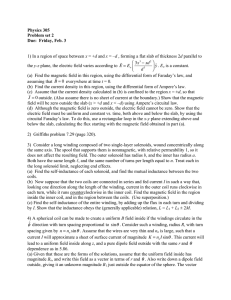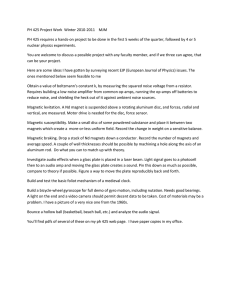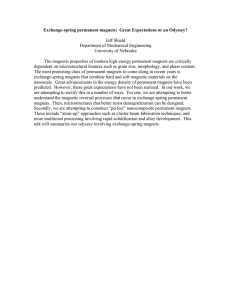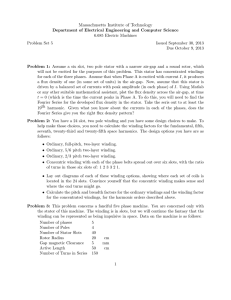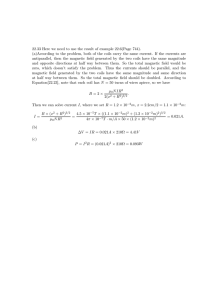Massachusetts Institute of Technology
advertisement
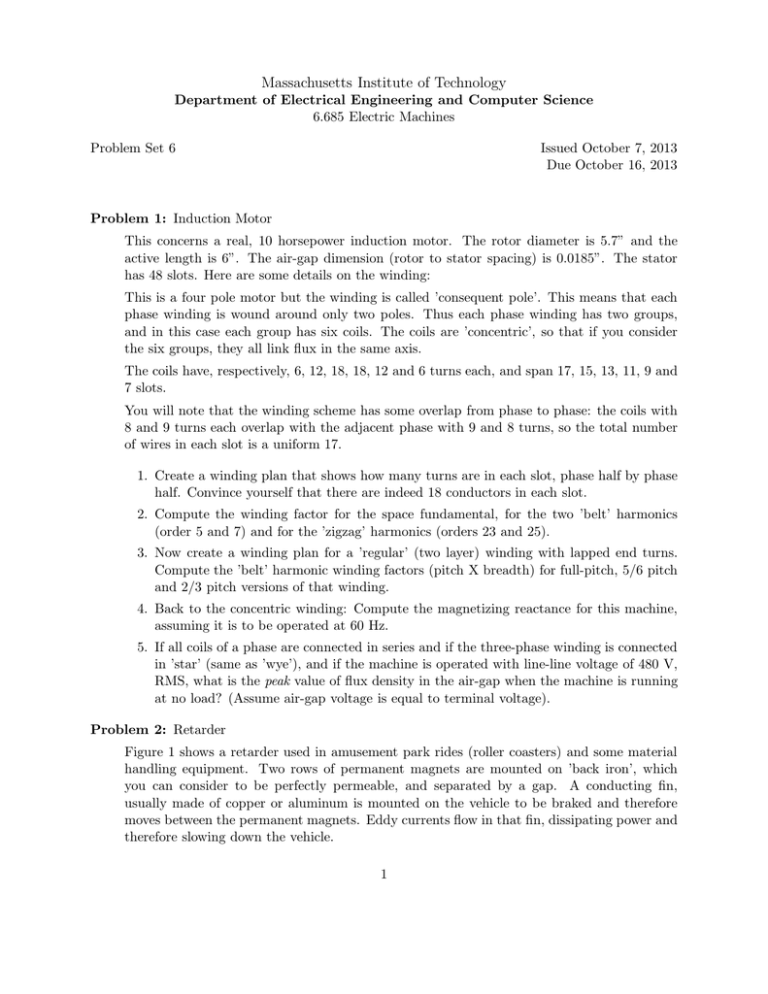
Massachusetts Institute of Technology
Department of Electrical Engineering and Computer Science
6.685 Electric Machines
Problem Set 6
Issued October 7, 2013
Due October 16, 2013
Problem 1: Induction Motor
This concerns a real, 10 horsepower induction motor. The rotor diameter is 5.7” and the
active length is 6”. The air-gap dimension (rotor to stator spacing) is 0.0185”. The stator
has 48 slots. Here are some details on the winding:
This is a four pole motor but the winding is called ’consequent pole’. This means that each
phase winding is wound around only two poles. Thus each phase winding has two groups,
and in this case each group has six coils. The coils are ’concentric’, so that if you consider
the six groups, they all link flux in the same axis.
The coils have, respectively, 6, 12, 18, 18, 12 and 6 turns each, and span 17, 15, 13, 11, 9 and
7 slots.
You will note that the winding scheme has some overlap from phase to phase: the coils with
8 and 9 turns each overlap with the adjacent phase with 9 and 8 turns, so the total number
of wires in each slot is a uniform 17.
1. Create a winding plan that shows how many turns are in each slot, phase half by phase
half. Convince yourself that there are indeed 18 conductors in each slot.
2. Compute the winding factor for the space fundamental, for the two ’belt’ harmonics
(order 5 and 7) and for the ’zigzag’ harmonics (orders 23 and 25).
3. Now create a winding plan for a ’regular’ (two layer) winding with lapped end turns.
Compute the ’belt’ harmonic winding factors (pitch X breadth) for full-pitch, 5/6 pitch
and 2/3 pitch versions of that winding.
4. Back to the concentric winding: Compute the magnetizing reactance for this machine,
assuming it is to be operated at 60 Hz.
5. If all coils of a phase are connected in series and if the three-phase winding is connected
in ’star’ (same as ’wye’), and if the machine is operated with line-line voltage of 480 V,
RMS, what is the peak value of flux density in the air-gap when the machine is running
at no load? (Assume air-gap voltage is equal to terminal voltage).
Problem 2: Retarder
Figure 1 shows a retarder used in amusement park rides (roller coasters) and some material
handling equipment. Two rows of permanent magnets are mounted on ’back iron’, which
you can consider to be perfectly permeable, and separated by a gap. A conducting fin,
usually made of copper or aluminum is mounted on the vehicle to be braked and therefore
moves between the permanent magnets. Eddy currents flow in that fin, dissipating power and
therefore slowing down the vehicle.
1
g
t
µ
111111111111111111111111111111111111111111
000000000000000000000000000000000000000000
000000000000000000000000000000000000000000
111111111111111111111111111111111111111111
u
111111111111111111111111111111111111111111
000000000000000000000000000000000000000000
µ
Figure 1: Cartoon of a Permanent Magnet Retarder
For the purpose of this exercise, assume the gap to be ’small’, meaning that kg << 1. The
conductive fin is moving to the right with velocity in the x direction u. The permanent
magnets produce a flux density at the location of the fin of: By = B0 cos kx. The eddy
currents in the fin will produce some reaction magnetic field. Find the retarding force density
per unit area as a function of fin speed u.
Problem 3: Fields in Free Space
Now we are going to solve a magnetic field problem without the assumption of a narrow
air-gap. This one is static. The situation is shown in Figure 2. A row of permanent magnets,
alternately polarized, is located on top of a perfectly permeable surface. It faces, across some
air-gap, another perfectly permeable surface.
µ
0000000000000000000000000000000000000000000
1111111111111111111111111111111111111111111
g
00000000000000000000000000000000000000000
11111111111111111111111111111111111111111
00000000000000000000000000000000000000000
11111111111111111111111111111111111111111
µ
h
Figure 2: Magnetic Problem
We will assume that the problem is linear so that we can treat magnetization of the magnets
as a fourier series, and then we will solve only for the space fundamental. The magnets will
have magnetization and incremental permeability, so that the y-directed flux density is:
By = Br cos kx + µm Hy
Magnetization in the magnets is purely in the y- direction, so that x- directed field is:
Bx = µ m H x
Magnetic field in the air gap is, as one would expect:
H
H = µ0 H
B
This simplified situation is shown in Figure 3.
This problem could be solved in a variety of ways: you could simply write down the form
H and the
of the magnetic field in the air-gap and in the magnet, realizing that the curl of H
divergence of B are both zero (it would not take long to discover the proper form of these
H can be found to be the gradient of a scalar
fields). Alternatively, you could realize that H
H = −∇ψ), and that this scalar potential satisfies Laplace’s equation:
potential (H
∇2 ψ = 0
2
air gap
µ
0000000000000000000000000000000000000000000
1111111111111111111111111111111111111111111
µ
0
g
111111111111111111111111111111111111111111
000000000000000000000000000000000000000000
11
µ00
µ
m
h
magnets
Figure 3: Magnetic Problem Cut Down To Size
In either case, you can use the boundary conditions that, at the upper and lower boundaries
(the iron boundaries), Hx = 0 (why?). And at the boundary between the magnets and the
air-gap, Hx must be continuous and By must be continuous.
In working this problem, you may find it convenient to set the value of y to be zero at the
boundary between the magnets and the air-gap.
1. First, assume that kg << 1 and find the magnetic flux density in the vertical (y)
direction. What is Hy in the magnet? Is this what you expect?
2. Now relax that assumption and find magnetic field Hy at the upper ferromagnetic sur­
face.
3. Finally, let the gap dimension go to infinity (that is, assume that there is no upper
boundary). Find expressions for magnetic field in the region above the magnets.
Problem 4: Non-Magnetic LIM
A prototypical linear induction motor is shown in Figure 4. The ’stator’ of this motor is the
lower element, and it carries a surface current of:
{
Kz = Re K0 ej(ωt−kx)
}
The ’shuttle’, which is the equivalent of the rotor of an ordinary induction motor, consists of
a layer of conductive material. You should consider the layer of material to be thin, and the
region ’behind’ (above) that layer has permeability µ0 , zero conductivity, and is deep enough
that there is no magnetic interaction with anything above the layer The ’shuttle’ is moving
to the right (the positive x direction) with velocity u.
g
σ =σt
s
µ=µ 0
u
11111111111111111111111111111111111111111
00000000000000000000000000000000000000000
00000000000000000000000000000000000000000
11111111111111111111111111111111111111111
µ
y
x
Kz
Figure 4: Cartoon of a notional linear induction motor
1. Derive an expression for the y- directed magnetic field in the air-gap as a function of
speed.
2. Use that expression to find force in the x- direction as a function of speed. Be sure to
consider speeds that are both smaller than and greater than the phase velocity uph = ωk .
3. Find the vertical (’lift’ or the opposite of ’lift’), also as a function of speed.
3
MIT OpenCourseWare
http://ocw.mit.edu
6.685 Electric Machines
Fall 2013
For information about citing these materials or our Terms of Use, visit: http://ocw.mit.edu/terms.
